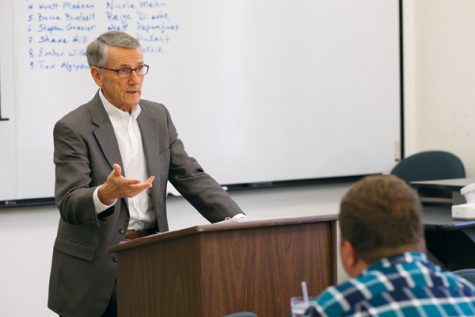Death by baseball
March 3, 2017
Carl Mays stood on the pitcher’s mound at the Polo Grounds in Manhattan, N.Y., working his way through the fifth inning of a soon-to-be infamous baseball game on Aug. 16, 1920.
At the plate was Cleveland Indians shortstop Ray Chapman, a batter known to crowd the plate: a habit that would prove costly for the 29 year old.
Mays had developed a reputation for throwing at hitters, a commonly used intimidation tactic. His insistence on connecting the baseball to flesh earned him a malicious record in 1917: most batters hit by a pitch. He would claim second place for the same record in both 1918 and 1919.
Mays’ pitches released just above the ground, a technique referred to as the “submarine pitch.” This form made his pitches difficult to hit, and in some cases, difficult to control.
Mays wound up, whipped his arm around and released the ball. The pitch sailed the 60 feet, six inches to home plate, where Chapman waited. It would be the last pitch Chapman ever saw.
At the time, the same ball would be used the duration of the game. In order to gain an advantage over the hitter, pitchers would routinely “dirty up” the ball. Dirt, tobacco spit and whatever else the pitcher could get away with was smeared over the ball.
Due to repeated use, the ball would not only become harder to see, it would become soft and misshapen: two traits that make accurate pitching more difficult as well.
The ball connected with the side of Chapman’s head. As batters were not required to wear batting helmets — and wouldn’t for several decades — the full force of the pitch was concentrated on Chapman’s skull.
The contact was so loud Mays assumed Chapman had managed to connect on a swing. As the ball bounced off Chapman’s head and back to the mound, Mays grounded the ball and threw to first as Chapman crumpled to the ground.
Chapman, bleeding from his ear and with a fresh laceration on his face, attempted to walk back to his dugout, located near deep center field. He collapsed near second base, where he was retrieved and rushed to the clubhouse.
12 hours later, after a failed surgery, Ray Chapman died. He remains the only MLB player to be killed by a pitch during a major league game.
The Cleveland Indians went on to win the game, 4-3. Later that same season, they would win both the pennant and the club’s first World Series Championship.
Nowadays, batters are required to wear helmets when they dig in at the plate. Due to other mishaps at the Minor League level, first and third base coaches are also required to wear batting helmets. But that’s another story for another time.
Baseballs are now replaced regularly during games as well. Look closely the next time you’re watching an MLB baseball game, if the ball hits the dirt during a pitch, the umpire will toss it aside and dig into a small pouch on his person, retrieving a new ball and either throwing it to the pitcher or handing it off to the catcher.
With Spring Training officially beginning, baseball is back in season. Major League teams are currently squaring off in either Florida or Arizona.
In what will seem like no time at all, opening day will be here and ballparks across America will be opening their gates for eager spectators, ready to reach back in time and enjoy the thrills and excitements so many millions have enjoyed for over a hundred years.
No matter your team, this time of year is exciting. The possibilities are endless. Will the defending World Series Champions, the Chicago Cubs, retake their crown? Will another powerhouse team take the thrown in late October? Or will an underdog with a carefully selected farm system of young talent rise above the teams with millions of dollars at their disposal?
Only time will tell. The season is young and the anticipation is great, but seeing baseball games taking place again is enough to invoke the smell of the ballpark in early summer.
In preparation for the quickly approaching opening day, stories of baseball legends, old and new, are worth sharing. Leading up to the first pitch of 2017, keep on eye out for tales from America’s oldest sport and greatest pastime: baseball.
Matt Eidson is the news editor for The Dakota Student. He can be reached at [email protected]






